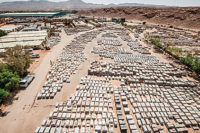Henraux’s stoneworking facility is equipped to produce a broad range of finished products, including artisan work. “What really took me aback was the fact that the entire spectrum of our industry was displayed right here in this one place,” said Ron Hannah of the SFA. “We saw gangsaws and wire saws cutting slabs; five-axis wire saws cutting the most intricate of shapes from blocks; the most amazing material-handling equipment; blocks processed into rough-cut slabs, resin-treated and then polished; fabrication by all sorts of high-tech gear and then right down to ‘old school’ handwork and carving of marble. We saw skilled craftsmen do things long thought as lost art.”
For many, the highlight of the tour was a visit to Henraux’s historic Cervaiole Quarry, which sits upon Mount Altissimo, one of the most celebrated peaks in the Apuan mountain range. The quarry’s material was said to have been used by Michelangelo, and it has a well-documented history that dates back for centuries.
Henraux has been operating the Cervaiole Quarry for nearly two centuries. In 1821, Jean Baptiste Henraux, a Frenchman that has been cited as a lieutenant of Napoleon Bonaparte, traveled to the Carrara region following the end of the Napoleonic Wars, and he founded the company that still bears his name today. He quickly reopened the Altissimo quarries, which had been closed during the wars, and it was used for prominent architectural works within Italy as well as other points in Europe.
The use of stone from the Cervaiole Quarry continued throughout the 20th century, and its material remains in high demand around the world today. Current extraction methods rely on Fantini chainsaws, along with heavy equipment for maneuvering. Diamond wire saws are used for block trimming and cutting large faces within the quarry.












